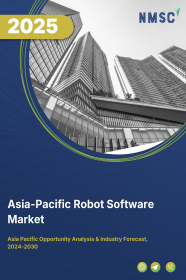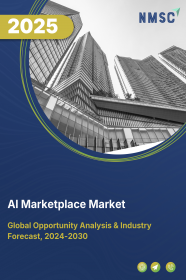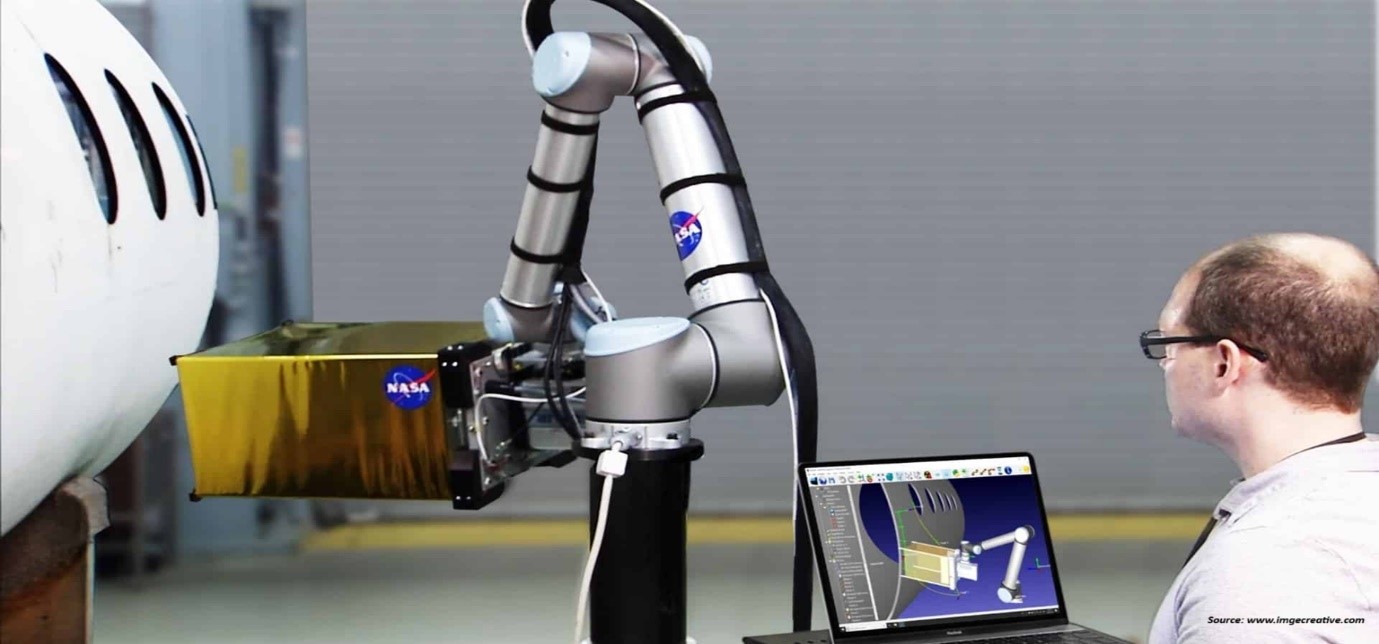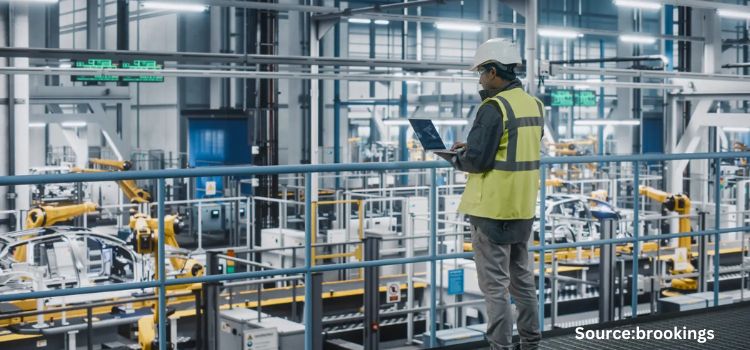
Asia-Pacific Robot Software Market by Software Type (Recognition Software, Simulation Software, Predictive Maintenance Software, Communication Management Software, and Data Management and Analysis Software), by Robot Type (Service Robots and Industrial Robots), by Deployment Mode (On-premise and On-demand), by Organization Size (Large Enterprises and Small and Medium-sized Enterprises (SMEs) – Opportunity Analysis and Industry Forecast, 2024–2030
Industry: ICT & Media | Publish Date: 14-Feb-2025 | No of Pages: 194 | No. of Tables: 133 | No. of Figures: 98 | Format: PDF | Report Code : IC2380
US Tariff Impact on Asia-Pacific Robot Software Market
Trump Tariffs Are Reshaping Global Business
Asia-Pacific Robot Software Market Overview
The Asia-Pacific Robot Software Market size was valued at USD 2.22 billion in 2023, and is expected to reach USD 11.93 billion by 2030, with a CAGR of 26.1% from 2024 to 2030. Robot software constitutes a suite of programs and algorithms crafted to supervise and govern the operations of robots or robotic systems in diverse industries such as logistics, manufacturing, entertainment, healthcare, and more. Its functionality encompasses several pivotal components.
Firstly, it coordinates and manages the movements and behaviors of robots, ensuring precise and efficient task execution by issuing detailed commands to robotic components such as motors and actuators.
Furthermore, robot software plays a critical role in interpreting data from various sensors embedded within robots, including cameras, Light Detection and Ranging (LIDAR) sensors, and tactile sensors. This data interpretation provides crucial environmental feedback that enables robots to accurately perceive and understand their surroundings. An essential aspect of robot software is its ability to make intelligent decisions utilizing artificial intelligence (AI) and machine learning (ML) algorithms.
Through the analysis of data from sensors, adherence to predefined rules, or learning from past experiences, robots can adapt to changing conditions, allowing them to operate autonomously and adjust their actions in real-time. Additionally, robot software facilitates communication and networking among robots, enabling collaboration for complex tasks or data exchange with a central control system. This interconnectedness facilitates synchronized operations in industrial environments, leading to enhanced efficiency and productivity.
Rising Labor Costs and Workforce Challenges Drive the Growth of the Asia-Pacific Robot Software Market
Rising labor costs and the ongoing challenges in workforce availability are significant drivers propelling the Asia-Pacific robot software market expansion in the region. With labor expenses on the ascent, particularly within industries heavily dependent on labor-intensive tasks, organizations are actively seeking solutions to contain costs while preserving productivity levels.
This growing inclination fuels widespread adoption of automation technologies, including robots, aimed at streamlining operations and reducing reliance on human labor. Central to this paradigm shift is the crucial role played by robot software, facilitating efficient programming, control, and optimization of robotic systems.
Furthermore, workforce challenges such as skill shortages and demographic shifts act as additional incentives for businesses to invest in robot software market, ensuring uninterrupted operations and competitiveness. Consequently, the robot software market witnesses sustained growth as organizations increasingly turn to automation to confront labor-related challenges and enhance operational efficiency.
Growing Focus on Safety and Compliance Propels the Asia-Pacific Robot Software Market
The growing emphasis on safety and compliance acts as a significant driver propelling the Asia-Pacific robot software market demand in the region. Heightened concerns about workplace safety and regulatory compliance lead organizations to prioritize the adoption of robot software solutions ensuring safe and compliant operation of robotic systems. Robot software plays a crucial role in implementing safety features, risk assessment tools, and compliance frameworks, mitigating the risk of accidents and ensuring adherence to industry regulations and standards.
Furthermore, as the regulatory landscape evolves and becomes more stringent, there's an increased demand for robot software enabling real-time monitoring, reporting, and documentation of safety and compliance metrics. By addressing these concerns and providing robust solutions for safe and compliant operation, the growing focus on safety and compliance drives the adoption of robot software across industries, stimulating market growth.
High Initial Investment for Acquiring Robot Hardware Restrain the Asia-Pacific Robot Software Market Growth
The significant upfront investment needed to procure robot hardware poses a notable obstacle to the Asia-Pacific robot software market growth in the region. Acquiring robot hardware entails substantial initial costs, including the purchase of robotic systems, peripherals, and related equipment.
These expenditures can be prohibitive for numerous organizations, particularly small and medium-sized enterprises (SMEs) or those with limited financial resources. The substantial financial commitment required for robot hardware may dissuade potential adopters from investing in robot software solutions, despite recognizing their potential long-term benefits.
Moreover, the high initial investment can prolong the return on investment (ROI) period, resulting in lengthier payback periods and constraining the scalability of robot deployments. Consequently, addressing the issue of high initial investment costs for robot hardware is pivotal to unlocking broader adoption and fostering growth in the market.
The Expansion of Robotics-as-a-Service Creates New Opportunities in the Asia Pacific Market
The proliferation of Robotics-as-a-Service (RaaS) brings forth new opportunities in the market by providing a more accessible and cost-effective pathway for organizations to deploy robotics solutions in the region. RaaS models enable businesses to access robotic hardware, software, and related services through subscription plans, eliminating the need for significant upfront investments in capital-intensive assets.
This approach reduces barriers to entry, particularly for small and medium-sized enterprises (SMEs) or entities with limited budgets, allowing them to utilize robotics technology without the financial burdens of ownership. Additionally, RaaS models often include maintenance, support, and software updates as part of the subscription, delivering added value and streamlining the deployment process.
Through democratizing access to robotics technology and fostering a pay-as-you-go model, the expansion of RaaS unlocks fresh market opportunities, driving adoption across various industries and catalyzing innovation in robot software solutions.
China Dominates the Asia-Pacific Robot Software Market Share
China dominates the Asia-Pacific robot software market share due to several factors. Firstly, the region boasts a massive manufacturing sector, driving significant demand for robotics and automation solutions, including robot software.
China's emphasis on industrial robots and technological advancement has fueled extensive adoption of robots across various industries, from automotive and electronics to healthcare and logistics. Additionally, favorable government policies and incentives aimed at promoting robotics and automation further stimulate market growth.
Moreover, China's robust ecosystem of technology companies, research institutions, and skilled workforce contributes to innovation and competitiveness in the robot software market. Overall, China's large market size, supportive policies, and technological capabilities position it as a leader in the Asia Pacific region for robot software adoption and deployment.
Thailand is Expected to Show Steady Rise in Asia-Pacific Robot Software Market
Thailand is expected to show a steady rise in the Asia-Pacific market due to several factors. Firstly, the region's strategic location in Southeast Asia makes it an attractive destination for manufacturing and investment, particularly in industries such as automotive, electronics, and food processing. As Thailand continues to position itself as a regional hub for production and export, there is increasing demand for automation solutions, including robot software, to enhance efficiency and competitiveness.
Additionally, government initiatives aimed at promoting industrial automation and Industry 4.0 adoption provide further impetus to market growth. Moreover, Thailand's skilled workforce, infrastructure development, and supportive business environment contribute to the favorable market outlook. Overall, with its growing industrial base and supportive policies, Thailand is poised to experience a steady rise in the Asia-Pacific market for robot software.
Competitive Landscape
Several key players operating in the Asia-Pacific robot software industry include IBM, NVIDIA, ABB Ltd., FANUC, Teradyne, Inc., H2O.ai, Brain Corp, CloudMinds, Clearpath Robotics, and Neurala, Inc. These market players are adopting strategies to maintain their dominance in the market.
Asia-Pacific Robot Software Market Key Segments
By Software Type
-
Recognition Software
-
Simulation Software
-
Predictive Maintenance Software
-
Communication Management Software
-
Data Management and Analysis Software
By Robot Type
-
Service Robots
-
Ground
-
Aerial
-
Underwater
-
-
Industrial Robots
-
Traditional Industrial Robots
-
Articulated Robots
-
SCARA Robots
-
Parallel Robots
-
Cartesian Robots
-
Other Robots
-
-
Collaborative Industrial Robots
-
By Deployment Mode
-
On-premise
-
On-demand
By Organization Size
-
Large Enterprises
-
Small and Medium-sized Enterprises (SMEs)
By Industry Vertical
-
Banking, Financial Services, and Insurance (BFSI)
-
Automotive
-
Retail and eCommerce
-
Aerospace & Defense
-
Healthcare and Life Sciences
-
Transportation and Logistics
-
Manufacturing
-
Telecommunications and IT
-
Academia and Research
-
Media & Entertainment
-
Others
By Country
-
China
-
Japan
-
India
-
Australia
-
South Korea
-
Thailand
-
Singapore
-
Rest of Asia-Pacific
REPORT SCOPE AND SEGMENTATION:
|
Parameters |
Details |
|
Market Size in 2023 |
USD 2.22 Billion |
|
Revenue Forecast in 2030 |
USD 11.93 Billion |
|
Growth Rate |
CAGR of 26.1% from 2024 to 2030 |
|
Analysis Period |
2023–2030 |
|
Base Year Considered |
2023 |
|
Forecast Period |
2024–2030 |
|
Market Size Estimation |
Billion (USD) |
|
Growth Factors |
|
|
Countries Covered |
8 |
|
Companies Profiled |
10 |
|
Market Share |
Available for 10 companies |
|
Customization Scope |
Free customization (equivalent up to 80 working hours of analysts) after purchase. Addition or alteration to region, regional, and segment scope. |
|
Pricing and Purchase Options |
Avail customized purchase options to meet your exact research needs. |
KEY PLAYERS
-
IBM
-
NVIDIA
-
ABB Ltd.
-
FANUC
-
Teradyne, Inc.
-
H2O.ai
-
Brain Corp
-
CloudMinds
-
Clearpath Robotics
-
Neurala, Inc.

















 Speak to Our Analyst
Speak to Our Analyst





















